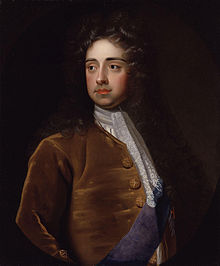
Back Lord High Treasurer Danish Lord High Treasurer German Lord High Treasurer Finnish Lord grand trésorier French הלורד הראשון של האוצר HE Lordfőkincstárnok (Egyesült Királyság) Hungarian Lord gran tesoriere Italian Groot-schatbewaarder Dutch Riksskattmester NB Lord wielki skarbnik Polish
| Lord High Treasurer of the United Kingdom | |
|---|---|
Charles Talbot, 1st Duke of Shrewsbury, last holder of the office as Lord High Treasurer of Great Britain in 1714 | |
| His Majesty's Treasury | |
| Type | Great Officer of State |
| Appointer | The Monarch |
| Term length | At His Majesty's Pleasure |
| Precursor |
|
| Formation |
|
| First holder | Nigel of Ely as Lord High Treasurer of England |
| Final holder | Charles Talbot, 1st Duke of Shrewsbury as Lord High Treasurer of Great Britain |
| Superseded by | Prime Minister of the United Kingdom and First Lord of the Treasury Chancellor and Under Treasurer of His Majesty's Exchequer and Second Lord of the Treasury Lords Commissioners of His Majesty's Treasury |
The Lord High Treasurer was an English government position and has been a British government position since the Acts of Union of 1707. A holder of the post would be the third-highest-ranked Great Officer of State in England, below the Lord High Steward and the Lord High Chancellor of Great Britain.
The Lord High Treasurer functions as the head of His Majesty's Treasury. The office has, since the resignation of Charles Talbot, 1st Duke of Shrewsbury in 1714, been vacant.
Although the United Kingdom of Great Britain and Ireland was created in 1801, it was not until the Consolidated Fund Act 1816 that the separate offices of Lord High Treasurer of Great Britain and Lord High Treasurer of Ireland were united into one office as the "Lord High Treasurer of the United Kingdom of Great Britain and Ireland" on 5 January 1817.[1]
Section 2 of the Consolidated Fund Act 1816 also provides that "whenever there shall not be [a Lord High Treasurer of the United Kingdom of Great Britain and Ireland], it shall ... be lawful for His Majesty, by letters patent under the Great Seal of Great Britain, to appoint Commissioners for executing the Offices of Treasurer of the Exchequer of Great Britain and Lord High Treasurer of Ireland".[1] These are the Lords Commissioners of the Treasury. In modern times, by convention, the Lords Commissioners of the Treasury include the Prime Minister of the United Kingdom, usually serving as the First Lord of the Treasury, and the Chancellor of the Exchequer, serving as the Second Lord of the Treasury. Other members of the government, usually whips in the House of Commons, are appointed to serve as the Junior Lords Commissioners of the Treasury.[2]
- ^ a b "Consolidated Fund Act 1816". legislation.gov.uk. UK Government. p. Section 2. Retrieved 18 November 2016.
- ^ Anson, Sir William Reynell (1892). The Law and Custom of the Constitution, Part 2. Oxford, Oxfordshire: Clarendon Press. pp. 163–164. Retrieved 19 October 2021.
